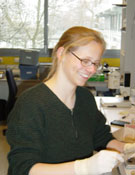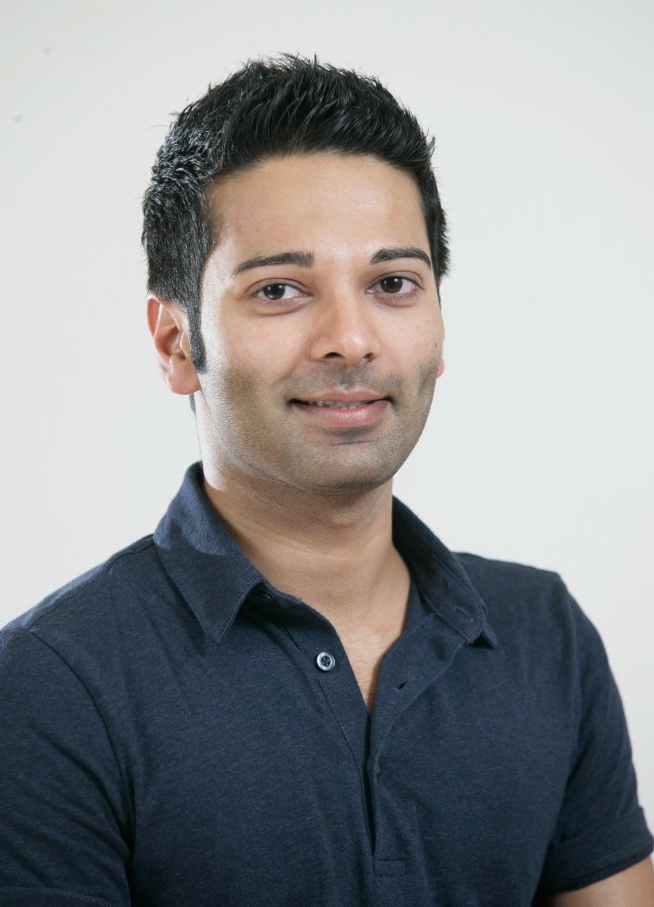
"You have made your way from worm to man, and much within you is still a worm" (Nieztsche)
Former Lab Members
Arno Alpi

The rad-5 DNA damage response gene
The role of Ce-Rad-51 in meiosis and DNA repair
PhD Student from April 2000 to 2004
Arno took on a postdoc at the MRC institute of Molecular Biology in Cambridge in the group of KJ Petal, to continue working on DNA damage responses starting in Mai 2004
Arno published several important papers during his Post Doc and recently accepted a group leader position at the Scottish Institute for Cell Signalling
Publications:
S. Moser, S. von Elsner, I. Buessing, A. Alpi, R. Schnabel, A. Gartner. (2009). Functional Dissection of C. elegans CLK2/TEL2 cell cycle defects during embryogenesis and germ line development, PLOS Genetics,April 5(4)
A. Bailly, A. Freeman, J. Hall, A. Déclais, A. Alpi, D. Lilley, S. Ahmed and A. Gartner (2010). The C. elegans homolog of Gen1/Yen1 resolvases links DNA damage signaling to DNA double-strand break repair, Plos Genetics, 6(7): e1001025.
S. Ahmed, A. Alpi, M. Hengartner and A. Gartner. (2001). C. elegans RAD-5/CLK-2 defines a new DNA damage checkpoint protein. Current Biology, Dec 11, 11(24): 1-20.
co-first author
A. Alpi, P. Pasierbek, A Gartner, J. Loidl. (2003). Genetic and cytological characterization of the recombination protein RAD-51 in Caenorhabditis elegans. Chromosoma, April 8
co-first author
C. Wicky, A. Alpi, M. Pressante, A. Rose, A. Gartner and F. Müller. (2004) Multiple genetic pathways involving C. elegans him-6/Blooms, mre-11, rad-51 and top-3 are needed to maintain genome stability in germ line, Mol Cell Biol. 24(11):5016-27.
A. Gartner, A. Alpi and B. Schumacher. (2003). Programmed Cell Death in C. elegans, Stefan Grimm ed. Bios
B. Schumacher, A. Alpi and A. Gartner. (2003). Cell cycle: Check for asynchrony, Current Biology;
Ashley Craig (2007 - 2011)

Ashley together with some of her friends started a company, Trivalent Editing, focused on editing and proofreading scientific manuscripts and medical documets.
Translational Control by GLD-1
1996 BSc Hons (1st Class) in Biochemistry, University of Dundee.
1996-2000 PhD Division of Pathology and Neuroscience, University of Dundee, Scotland. Ted Hupp Laboratory
2000-2004 Post Doc Division of Pathology and Neuroscience, University of Dundee, Scotland. Ted Hupp Laboratory
2004-2007 RSE Lloyds/TSB Research Fellow Cell Signalling Unit, Edinburgh Cancer Research Centre, University of Edinburgh, Scotland
Publications:
R. Rutkowski, R Dickinson, G. Stewart, A. Craig, M. Schimpl, S. Keyse, and A. Gartner (2011) ERK signalling is activated by irradiation and positively regulates CEP-1/p53 dependent apoptosis in C. elegans, Plos Genetics, 7(8): e1002238
A. Craig S. Moser AP. Bailly and A. Gartner. (2011). “Methods to study C. elegans DNA damage responses” in press, in the ‘Methods in Cell Biology’ series,
R. Sonneville, M. Querenet. A. Craig, A. Gartner* and J. Blow (2011). The dynamics of replication licensing in live C. elegans embryos, Journal of Cell Biology in press “
Craig AL, Chrystal JA, Fraser JA, Sphyris N, Lin Y, Harrison BJ, Scott MT, Dornreiter I, Hupp TR. The Mdm2 ubiquitination signal in the DNA binding domain of p53 forms a docking site for calcium calmodulin superfamily members. (2007) MCB 27:3542-55.
Craig AL and Hupp TR. The regulation of CHK2 in human cancer. (2004) Oncogene 23:8411-8.
Pohler E, Craig AL, Cotton J, Lawrie L, Dillon JF, Ross P, Kernohan N, Hupp TR. The Barrett's antigen anterior gradient-2 silences the p53 transcriptional response to DNA damage. (2004) Mol Cell Proteomics 3:534-47.
Craig AL, Scott M, Burch LR, Smith G, Ball KL, Hupp TR. Allosteric effects mediate CHK2 phosphorylation of the p53 transactivation domain. (2003) EMBO Rep 4:787-792.
Signaling to p53: The Use of Phospho-Specific Antibodies to Probe for in vivo Kinase Activation. AL Craig, LR Burch, SE Bray, LE Finlan, NM Kernohan, and TR Hupp. (2002) P53 Methods. Edited by Sumitra and Swati Deb. Humana Press.
Yagui-Beltran A, Craig AL, Lawrie L, Thompson D, Pospisilova S, Johnston D, Kernohan N, Hopwood D, Dillon JF, Hupp TR. The human oesophageal squamous epithelium exhibits a novel type of heat shock protein response. (2001) Eur J Biochem 268:5343-55.
Blaydes JP, Craig AL, Wallace M, Ball HM, Traynor NJ, Gibbs NK, Hupp TR. Synergistic activation of p53-dependent transcription by two cooperating damage recognition pathways. (2000) Oncogene 10:3829-39.
Webley K, Bond JA, Jones CJ, Blaydes JP, Craig AL, Hupp T, Wynford-Thomas D. Posttranslational modifications of p53 in replicative senescence overlapping but distinct from those induced by DNA damage. (2000) Mol Cell Biol 20:2803-8.
Bond, JA, Webley K, Wyllie FS, Jones CJ, Craig AL, Hupp T, Wyndford-Thomas D. P53-dependent growth arrest and altered p53-immunoreactivity following metabolic labelling with 32P ortho-phosphate in human fibroblasts. (1999) Oncogene 18:3788-3792.
Craig AL, Blaydes JP, Burch LR, Thompson AM, Hupp TR. Dephosphorylation of p53 at Ser20 after cellular exposure to low levels of non-ionising radiation. (1999) Oncogene 18:6305-12.
Craig AL, Burch L, Vojtesek B, Mikutowska J, Thompson A, Hupp TR. Novel phosphorylation sites of human tumour suppressor protein p53 at Ser20 and Thr18 that disrupt the binding of mdm2 (mouse double minute 2) protein are modified in human cancers. (1999) Biochem J 15:133-41.
Baculovirus expression and the study of the regulation of the tumour suppressor protein p53. CA Midgley, AL Craig, JP Hite, and TR Hupp. (1998) DNA Transfer to Cultured Cells. Edited by Katya Ravid and R. Ian Freshney (ISBN 0-471-16572-7) Wiley-Liss Inc.
Black C, Withers AP, Gray JR, Bridges AB, Craig AL, Baty DU & Boxer M. Correlation of a recurrent FBN1 mutation (R122C) with an atypical familial Marfan syndrome phenotype. Hum. Mutation (1998) Suppl 1:S198-200
Millam S, Mitchell S, Craig AL, Paoli M, Moscheni E, Angelini L. In vitro manipulation as a means for accelerated improvement of some new potential oil crop species. (1997) Industrial Crops and Products 6: 213-219.
Craig AL and Millam S. Modification of oilseed rape to produce oils for industrial use by means of applied tissue culture technology. (1995) Euphytica 85: 323-327.
Craig AL, Morrison I, Baird E, Waugh R, Coleman M, Davie P, and Powell W. Expression of reducing sugar accumulation in interspecific somatic hybrids of potato. (1994) Plant Cell Reports 13:401-405.
Aymeric Bailly

Aymeric is continuing to work with C. elegans and jointed the group of Dimitris Xirodimas at the Macromolecular Biochemistry Research Centre in Montpellier, France
Mutants defective in DNA damage responses.
PhD Student since December 2003 - Postdoc 2009/2010
Publications:
A. Bailly, A. Freeman, J. Hall, A. Déclais, A. Alpi, D. Lilley, S. Ahmed and A. Gartner (2010). The C. elegans homolog of Gen1/Yen1 resolvases links DNA damage signaling to DNA double-strand break repair, Plos Genetics, 6(7): e1001025.
A. Bailly and A. Gartner. (2011). C. elegans DNA damage responses in “Molecular Determinants of Radiation Response”, Springer press, March 23rd 2010
- Craig S. Moser AP. Bailly and A. Gartner. (2011). “Methods to study C. elegans DNA damage responses” in press, in the ‘Methods in Cell Biology’ series,
- Bailly and A. Gartner. (2011). Germ cell apoptosis and DNA damage responses, in “The C. elegans germ line”, Springer press, in press
- A. Bailly and A. Gartner. (2011). C. elegans DNA damage responses in “Molecular Determinants of Radiation Response”, Springer press, March 23rd 2010”
N. Grandin, A. Bailly and M. Charbonneau. (2005) "Activation of Mrc1, a mediator of the replication checkpoint, by telomere erosion." Biology of the Cell (2005) 97, (799-814)
A. Bailly, AC. Déclais, J. Hall, A. Freeman, A. Alpi, D. Lilley, S. Ahmed and A. Gartner. (2009). The C. elegans Gen-1 Holliday Junction Resolvase like enzyme links DNA double strand break repair and DNA damage signalling, submitted.
Awards:
2nd year post-graduate students' poster competition, School of Life Sciences, University of Dundee (2nd).
Annual meeting of the Biochemical Society 2008, post-graduate students' poster competition (1st).
Björn Schumacher

The C. elegans p53 pathway.
Transcriptional targets of cep-1/p53
Negative regulation of cep-1/p53 by gld-1
PhD Student 2000 - 2004
Björn started his Post Doc at the at the University of Rotterdam in the lab of Jan Hoeijmakers to work on the interplay between DNA repair and the process of aging starting in July 2004. Since then he has received both EMBO and Marie Curie Post Doctoral fellowships.
Björn published several papers in the field of aging and recently took on a group leader position at the University of Cologne, Germany. He also won a prestigious ERC Junior Investigator award.
Publications:
B. Schumacher, K. Hofmann, S. Boulton and A. Gartner. (2001). The C. elegans homolog of the p53 tumor suppressor is required for DNA damage induced apoptosis. Current Biology, Oct 30; 11(21):1722-7.
B. Schumacher, A. Alpi and A. Gartner. (2003). Cell cycle: Check for asynchrony, Current Biology
B. Schumacher, M. Hanazawa, MH. Lee, S. Nayak, K. Volkmann; R. Hofmann, M. Hengartner, T. Schedl and A. Gartner (2005).Translational Repression of C. elegans p53 by GLD-1 regulates DNA damage induced apoptosis. Cell 120: 357-368
B. Schumacher, C. Schertel, N.Wittenburg, S. Tuck, S. Mitani, A. Gartner, B. Conradt and SC. Shaham. (2005). C. elegans ced-13 can promote apoptosis and is induced in response to DNA damage. Cell Death Differ. 2005 12(2):153-61 Co-corresponding author
B. Schumacher and A. Gartner (2006) Translational regulation of p53 as a potential tumor therapy target. Future Oncol. 2(1), 145-153 145
Giulio Maffioletti

Giulio left science and trained as a physiotherapist.
S-phase checkpoint regulation
Post doc from January 2005 - 2008
Giulio did his PhD in the Foiani and Libreri labs in Milano
Publications:
Rad51-dependent DNA structures accumulate at damaged replication forks in sgs1 mutants defective in the yeast orthologue of BLM RecQ helicase. Giordano Liberi*, Giulio Maffioletti*, Chiara Lucca , Irene Chiolo, Anastasia Baryshnikova, Cecilia Cotta-Ramusino, Massimo Lopes , Achille Pellicioli, James E. Haber and Marco Foiani (2005). GENES & DEVELOPMENT 19:339-350, 2005
*Co-first author
The protein complex containing Srs2, Sgs1 and Mre11 yeast repair factors is reorganized in response to DNA damage.Irene Chiolo, Walter Carotenuto, Giulio Maffioletti, John H. Petrini, Marco Foiani and Giordano Liberi (2005). Mol Cell Biol. 5(13):5738-51
Katrin Volkmann

The C. elegans p53 pathway.
Diploma Student from November 2003 to November 2004
Katrin did her PhD at the GSF in Munich, Germany
Katrin is now Post Doctoral Researcher at the Sanger Centre.
Publications:
B. Schumacher, M. Hanazawa, MH. Lee, S. Nayak, K. Volkmann; R. Hofmann, M. Hengartner, T. Schedl and A. Gartner (2005).Translational Repression of C. elegans p53 by GLD-1 regulates DNA damage induced apoptosis. Cell 120: 357-368
Pablo Ibáñez Cruceyra (2006 - 2010)

Pablo is continuing to work with worm, and we are following up on the projects he started in my lab. Pablo is now a senior postdoc in the laboratory of Jean-Louis Bessereau, in Paris.
2005: Ph D (Université René Descartes-Paris 5, France)
2001: DEA Biology of Aging (Université Pierre et Marie Curie-Paris 6, France)
1997-2000: License, Master Biochemistry (Université Denis Diderot-Paris 7, France)
Research Experience
2006-present: Dundee University (School of Life Sciences, Dundee, UK) PI Dr Anton GARTNER (C.elegans Genetics)
2006: I.N.S.E.R.M. U.289 (Hôpital de la Pitié Salpêtrière, Paris, France) Post-doc in Pr. BRICE lab (Neurogenetics)
2001-2005: I.N.S.E.R.M. U.289 (Hôpital de la Pitié Salpêtrière, Paris, France) Ph D, advisor Pr. BRICE (Neurogenetics)
2000-2001: I.N.S.E.R.M. U.289 (Hôpital de la Pitié Salpêtrière, Paris, France) D.E.A. advisor Dr. RAIZMANN (Neurology)
2000: UNIVERSITAT BAYREUTH (Bayreuth, Germany) ERASMUS advisor Pr. KRAUSS (Biochemistry)
1999: UNIVERSIDAD COMPLUTENSE DE MADRID (Madrid, Spain) Predoctoral Research Fellow (Neurobiology)
1996: UNIVERSIDAD COMPLUTENSE DE MADRID (Madrid, Spain) Predoctoral Research Fellow (Immunology)
Publications:
Ibanez, P., Lesage, S., Janin, S., Lohmann, E., Durif, F., Destee, A., Bonnet, A.M., Brefel-Courbon, C., Heath, S., Zelenika, D. et al. (2009) Alpha-synuclein gene rearrangements in dominantly inherited parkinsonism: frequency, phenotype, and mechanisms. Arch Neurol, 66, 102-8.
Leutenegger, A.L., Salih, M.A., Ibanez, P., Mukhtar, M.M., Lesage, S., Arabi, A., Lohmann, E., Durr, A., Ahmed, A.E. and Brice, A. (2006) Juvenile-onset Parkinsonism as a result of the first mutation in the adenosine triphosphate orientation domain of PINK1. Arch Neurol, 63, 1257-61.
Ibanez, P., Lesage, S., Lohmann, E., Thobois, S., De Michele, G., Borg, M., Agid, Y., Durr, A. and Brice, A. (2006) Mutational analysis of the PINK1 gene in early-onset parkinsonism in Europe and North Africa. Brain, 129, 686-94.
Lesage, S., Leutenegger, A.L., Ibanez, P., Janin, S., Lohmann, E., Durr, A. and Brice, A. (2005) LRRK2 haplotype analyses in European and North African families with Parkinson disease: a common founder for the G2019S mutation dating from the 13th century. Am J Hum Genet, 77, 330-2.
Lesage, S., Ibanez, P., Lohmann, E., Pollak, P., Tison, F., Tazir, M., Leutenegger, A.L., Guimaraes, J., Bonnet, A.M., Agid, Y. et al. (2005) G2019S LRRK2 mutation in French and North African families with Parkinson's disease. Ann Neurol, 58, 784-7.
Corti, O., Hampe, C., Darios, F., Ibanez, P., Ruberg, M. and Brice, A. (2005) Parkinson's disease: from causes to mechanisms. C R Biol, 328, 131-42.
Ibanez, P., Lohmann, E., Pollak, P., Durif, F., Tranchant, C., Agid, Y., Durr, A. and Brice, A. (2004) Absence of NR4A2 exon 1 mutations in 108 families with autosomal dominant Parkinson disease. Neurology, 62, 2133-4.
Ibanez, P., Bonnet, A.M., Debarges, B., Lohmann, E., Tison, F., Pollak, P., Agid, Y., Durr, A. and Brice, A. (2004) Causal relation between alpha-synuclein gene duplication and familial Parkinson's disease. Lancet, 364, 1169-71.
Itier, J.M., Ibanez, P.*, Mena, M.A., Abbas, N., Cohen-Salmon, C., Bohme, G.A., Laville, M., Pratt, J., Corti, O., Pradier, L. et al. (2003) Parkin gene inactivation alters behaviour and dopamine neurotransmission in the mouse. Hum Mol Genet, 12, 2277-91.
(*co-first author)
Ibanez, P., De Michele, G., Bonifati, V., Lohmann, E., Thobois, S., Pollak, P., Agid, Y., Heutink, P., Durr, A. and Brice, A. (2003) Screening for DJ-1 mutations in early onset autosomal recessive parkinsonism. Neurology, 61, 1429-31.
Bonifati, V., Rizzu, P., van Baren, M.J., Schaap, O., Breedveld, G.J., Krieger, E., Dekker, M.C., Squitieri, F., Ibanez, P., Joosse, M. et al. (2003) Mutations in the DJ-1 gene associated with autosomal recessive early-onset parkinsonism. Science, 299, 256-9.
Lipps, G., Ibanez, P., Stroessenreuther, T., Hekimian, K. and Krauss, G. (2001) The protein ORF80 from the acidophilic and thermophilic archaeon Sulfolobus islandicus binds highly site-specifically to double-stranded DNA and represents a novel type of basic leucine zipper protein. Nucleic Acids Res, 29, 4973-82.
Rachael Rutkowski

Rachael took on a senior postdoctoral position in the laboratory of Clare Scott at the WEHI institute in Melboure, Australia.
Negative Regulation of cep-1/p53
Post Doc since January 2005 - 2010
Rachel came to us all the way from Townsville in north-eastern Australia where she did her PhD with Bill Warren
Publications:
R. Rutkowski, K. Hofmann, A. Gartner. (2010). Phylogeny and Function of the Invertebrate p53 Superfamily, Cold Spring Harbor Persepect. Biol. 2010 Jul; 1; 2(7) Epub May5.
R. Rutkowski, K and A. Gartner. (2010). Tagging the dead a bridging factor for Caenorhabditis elegans phagocyte receptors. Nature Cell Biol. Jul; 12(7) 638-640.
R. Rutkowski, R Dickinson, G. Stewart, A. Craig, M. Schimpl, S. Keyse, and A. Gartner (2011) ERK signalling is activated by irradiation and positively regulates CEP-1/p53 dependent apoptosis in C. elegans, Plos Genetics, 7(8): e1002238”
Rutkowski, R., Stewart, G., Schimpl, M., Schedl, T., Keyse, S., and Gartner, A. Ras MAPK signalling regulates cep-1/p53 dependent apoptosis in C. elegans. Manuscript in preparation.
Rutkowski, R. and Warren, W. (2009). Phenotypic analysis of deflated/Ints7 function in Drosophila development. Developmental Dynamics. In press.
Sandra Moser

The biochemistry of the C. elegans DNA damage response pathway.
PhD Student since December 2003 - 2008
Sandra is now a Post Doc with Dr. Jason Swedlow in Dundee
Publications:
J. Mouysset, A. Deichsel, S. Moser C. Hoege, A. Hyman, A. Gartner, T. Hoppe. (2008). Cell cycle progression requires the CDC-48UFD-1/NPL-4 complex for efficient DNA replication. Proc Natl Acad Sci, USA, Sep, 105(35): 12879-84.
S. Moser, S. von Elsner, I. Buessing, A. Alpi, R. Schnabel, A. Gartner. (2009). Functional Dissection of C. elegans CLK2/TEL2 cell cycle defects during embryogenesis and germ line development, PLOS Genetics, in press
Sebastian Greiss

Sebastian is now working as a postdoctoral research assistant with Jason Chin at the Laboratory for Molecular Biology in Cambridge, UK.”
The role of histone deacetylases in irradiation induced programmed cell death
Transcriptional targets of cep-1/p53
PhD Student and Postdoc since October 2003 - 2009
Sebastian recently published a paper where he first described the expansion of the genetic code in animas such that artificial amino acids could be incoporated into C. elegans. J. Am. Chem.Soc. 2011, 1333(36):14196-9.”
Publications:
S. Greiss, B. Schumacher, K. Grandien, J. Rothblatt, A. Gartner. (2008). Transcriptional profiling in C. elegans suggests DNA damage dependent apoptosis as an ancient function of the p53 family. BMC Genomics. Jul 15; 9: 334.
J. Mouysset, A. Deichsel, S. Moser C. Hoege, A. Hyman, A. Gartner, T. Hoppe. (2008). Cell cycle progression requires the CDC-48UFD-1/NPL-4 complex for efficient DNA replication. Proc Natl Acad Sci, USA, Sep, 105(35): 12879-84.
A. Gartner, PR. Boag and TK. Blackwell (2008). Germline Survival and Apoptosis, WormBook, ed. The C. elegans Research Community, WormBook, Sept; 1-20
S. Greiss, J. Hall, S. Ahmed, A. Gartner. C. elegans SIR-2.1 translocation is linked to a pro-apoptotic pathway parallel to cep-1/p53-like during DNA damage induced apoptosis (2008) Genes & Development, Oct, 22(20): 2831-41.
Alper Akay

left 2013, Postdoc at Gurdon, Cambridge, UK
Translational Control by GLD-1
Publications:
Feitsma, H., A. Akay, and E. Cuppen (2008), 'Alkylation damage causes MMR-dependent chromosomal instability in vertebrate embryos', Nucleic Acids Res.
Ana Agostinho

Postdoc at Karolinska Insitute, Stockholm, Schweden
Apoptosis Regulation
Publications:
C. MacKay, A. Déclais, C. Lundin, A. Agostinho, A. Deans, T. MacArtney, K. Hofmann, A. Gartner, S. West, T. Helleday, D. Lilley and J. Rouse (2010). Identification of KIAA1018/FAN1, a DNA repair nuclease recruited to DNA damage by monoubiquitinated FANCD2. Cell, 142(1)65-76
Ehsan Pourkarimi

Postdoc at Sloan Kettering, New York, USA
Germ cell Apoptosis Regulation
2001-2007 M.Sc in Molecular Genetics, Eotvos Lorand University, Budapest, Hungary
2007- PhD Student
Publications:
E. Pourkarimi, S. Greiss and A. Gartner (2011) Evidence that CED-9/Bcl2 and CED-4/Apaf-1 localization is not consistent with the current model for C. elegans apoptosis induction, Cell Death and Differentiation, (Epub) cdd.2011.104
Joerg Weiss

2013 - Present - Berlin, Germany
04/2011 - 2013
University of Dundee, UK External Diploma Thesis (9 months research:) "Whole Genome mutation profiling in C. elegans"
09/2009 - 09/2011
Acadia University, NS, Canada. Student Exchange
09/2007 - present
University of Freiburg, Germany. Diploma in Biology (MSc)
09/2005 - 08/2007
University of Hohenheim, Germany. First 2 years of undergraduate studies in biology.
Neda Masoudi

2013 - present - Postdoc Columbia University, New York, USA
2008-2013 PhD Student
2003-2008 M.Sc in Molecular Genetics, Eotvos Lorand University, Budapest, Hungary
Alexander Holmes

Alex did his PhD on membrane traffic and cell adhesion in C. elegans in the Pettit Lab at the University of Aberdeen, where he graduated in 2007. Following that, and in search of warmer climes, he did a post-doc at the Universite de Rennes 1 in France, were he studied the contribution of membrane traffic to EGF/Ras signalling during C. elegans vulval development. Missing the subtleties of the Scottish weather he returned to the UK in late 2010 when he joined the Gartner Lab.
Publications:
Holmes, A., A. Flett, et al. (2007). "C. elegans Disabled is required for cell-type specific endocytosis and is essential in animals lacking the AP-3 adaptor complex." Journal of Cell Science 120(15): 2741-2751.
Alexander is now a Database Curator at the EBI.
Virkram Narayam

With many developed countries, including the UK, being described as having ageing populations (more people over 60 than under 16), it is imperative to identify a means to increase the healthy lifespan of the population by delaying the onset of age-associated illnesses. Recently, long-lived mutant worms and mice were discovered that show an increased resistance to a variety of stresses, making them less likely to succumb to tumours, neurological disorders and other age-associated illnesses. Thus, elucidating the mechanism of ageing itself and understanding the cellular changes accompanying it will not only improve our quality of life, but also further our knowledge of disease-development.
Ageing was initially believed to be a haphazard process based on early observations of the progressive, seemingly disorganised deterioration of tissues and vital body functions in aged individuals. However, it is now known to be a regulated biological process controlled by multiple signalling pathways. Our knowledge of these ‘ageing pathways’ comes primarily from genetic studies in model organisms, the best characterised of which is the roundworm Caenorhabditis elegans. Worms are particularly suited to ageing studies: being hermaphrodites, they can be clonally propagated and isogenic worm lines can be examined; they have a short reproductive cycle; their normal lifespan is no more than 3 weeks; and they are amenable to advanced forward/reverse genetics procedures.
I focus on using C elegans to address the fundamental question: What really is ageing? I use quantitative proteomics strategies set up by the Gartner & Lamond labs to measure changes in protein levels and dynamics – sub-cellular localization, turnover, post-translational modifications – occurring during the course of ageing in C elegans. I believe this in-depth proteome analysis will help me characterise the molecular changes accompanying ageing; I hope to use this information to improve health and quality of life in the elderly.
The Wellcome Trust funds my research through the award of a Sir Henry Wellcome Postdoctoral Fellowship. This allows me to merge the expertise of the Kenyon Lab in San Francisco (Cynthia Kenyon is one of the pioneers of research into ageing – her studies continue to redefine the field and shed insight into the genetics of ageing) with that of the Gartner & Lamond Labs in Dundee.
Vikram recently started to work at Calico a company funded by Google, and continues to focus on aging research.